War Remnants Museum
Letter #23: Skip this newsletter if you only want to read about rainbows and butterflies. 🤣
3/16/23
**Trigger warning for gore images & description of war**
Vietnam is an interesting place, to say the least. It almost seems set back in time, some of the practices so primitive, a very DIY culture to the entire place. And yet it also demonstrates the speed and agility with which new construction and new technology can be developed every day. In the packed cities, buildings seem thrown together with very few rules to follow—I’m not certain that building code violations are a thing here. People are hawking goods everywhere on the street, even selling straight off their bicycles. No need for selling permits here. 🤷🏻♀️
Full families of 4 people crammed onto one scooter, sometimes with a dog, weaving through traffic. You might see a guy using one hand to balance an 8 foot metal pipe over his left shoulder, the other hand guiding his handlebars through the streets. How he makes a turn without taking out 5 other drivers is what makes this place so astounding.
The produce is purchased fresh every morning. Meat sits out in the open of the food stalls, having freshly been killed. Eggs are never, ever refrigerated. Freshly caught fish sit out in the open, or sometimes still alive in buckets of water, extra fresh for buyer’s choice. No refrigeration sounds primitive, right? But it’s not. Your meals are made using the freshest of ingredients, picked or killed that morning or the evening before. It is a far cry from the multiple fridges and deep freezers many households have back in the US, packed with food to save for a later date.
On Sunday, I visited the War Remnants Museum. I expected the experience to be a tough pill to swallow—but it was much worse than I had imagined. I didn’t remember much about what I learned of the Vietnam War back in high school. And I only had references from films like Full Metal Jacket, Platoon, and Apocalypse Now’'—all of which are told from an American perspective. But how does that saying go? “There are two sides to every story”…and somewhere in between lies the truth.
As I had mentioned before, part of me taking this journey is to answer some of my questions about my own country’s history. Why I can’t just love it blindly, why I have to poke holes in what I’m told. And regardless of anyone’s stance of the US’ involvement in the Vietnam War, what I saw that day led to tears streaming down my face. Images of farmers, their legs thinner than my own forearms, being gunned down by US soldiers. Women and children killed with reckless abandon in their homes, their rural villages burned to the ground as the end of the war created further pressure on the troops to kill anything and everything in sight. Accounts of civilian bodies laid next to each other to form a “measuring stick”, a way for soldiers to measure their success by body count, turning into a fierce competition between units.
In 1925, members of the UN signed the Geneva Protocol, a treaty prohibiting “Use in War of Asphyxiating, Poisonous or Other Gases, and of Bacteriological Methods of Warfare.” Including the US. And yet the museum showcased so much evidence of the harrowing effects of Agent Orange, a chemical herbicide with damaging environmental impacts, and the presence of dioxin leading to MAJOR health issues to the people who are exposed, including offspring. Generations of Vietnamese people post the conclusion of the war (and the victorious North, and Communist party) in 1975, are STILL battling the affects of Agent Orange. It’s still being passed down through families, and the affects are grim. Regardless of right or wrong, which countries have abused the Geneva Protocol, skirting around the fine print—it was devastating to know the US was involved in the creation of these images that were ripping my heart to shreds. The US spent nearly $168 billion on this war ($1 trillion in today’s dollars), its direct involvement lasting 8 years. Double the price of WWII. The US lost 58,159 soldiers in the war. The Vietnamese lost 2 million people during the war, and are still being affected by undetonated bombs littering rural areas of country.


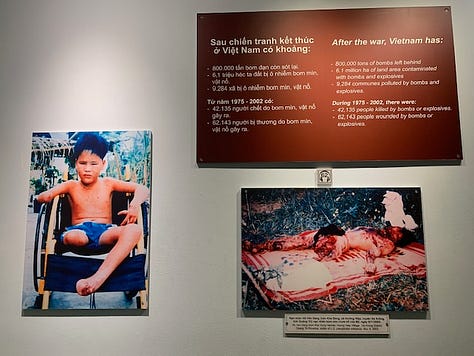
But why? To fight against the spread of communism? To protect foreign interest? It was hard for me to wrap my head around the reasons from the past. It took me so long to fly over here, why were our troops so far from home? I was met with welcoming smiles by the locals here (well, for the most part), and I was in awe that Americans are welcomed here at all, when the past is so dark.
Miraculously, I didn’t have nightmares that night. I met up with Cee for dinner and we continued sharing minute comparisons between our countries. But there is no way I can unsee and unlearn what I came to know that day in the museum. And it helps me understand WHY I question all I’ve been told in the past, even if I have to travel to countries on the other side of the world to learn the other side of the truth.
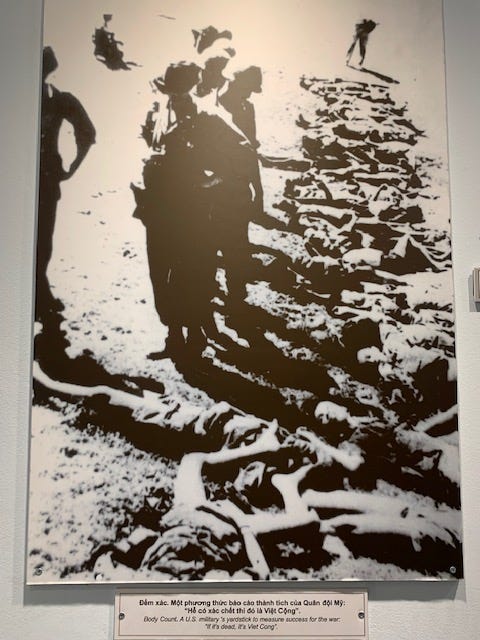
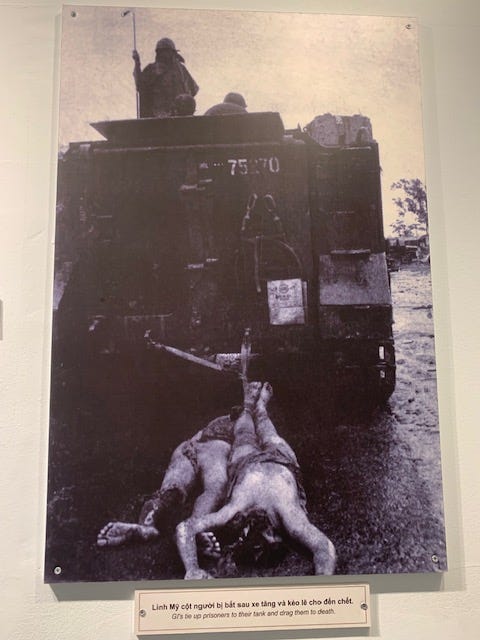
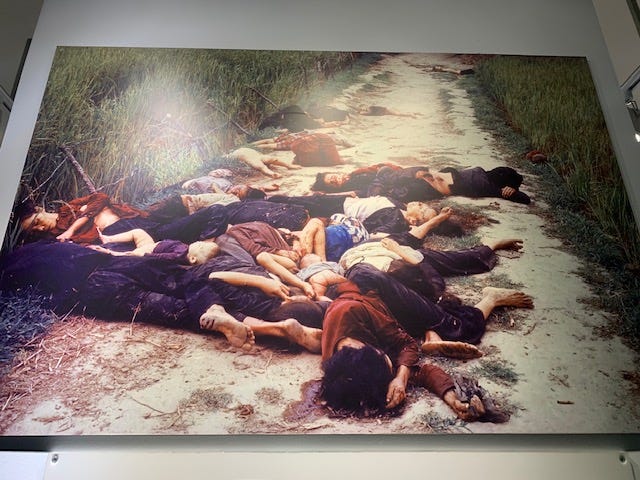

FOOD TIME
Ok, ready for something a littler lighter? Here is a recount of my FAVORITE foods I tried in Vietnam.
“Bún chả is aVietnamese dish of grilled pork and noodles, which is thought to have originated from Hanoi, Vietnam. Bún chả is served with grilled fatty pork (chả) over a plate of white rice noodles (bún) and herbs with a side dish of dipping sauce.” This was the first local dish I ate with Cee and it blew my mind. It was packed with so much flavor, so savory, and I loved the heaping bowl of herbs served on the side that could be added into the broth.
“Bánh cuốn is made from a thin, wide sheet of fermented rice batter filled with a mixture of cooked seasoned ground pork, minced wood ear mushroom, and minced shallots. Sides for this dish usually consist of chả lụa (Vietnamese pork sausage), sliced cucumber, and bean sprouts, with the dipping sauce which is fish sauce called nước chấm (Nuoc Mam).” This was the second absolute TREAT of a local meal I ate with Cee. The little spring rolls of minced meat and mushroom dipped in a sweet fish oil broth were SO GOOD. She referred to it as a “light snack” for midday, but I happened to eat the whole dish it was too good to waste any of it, and was thus stuffed to the brim post “snack”. 🤣
“Cao lầu is a regional Vietnamese noodle dish, from the city of Hội An, in central Vietnam's Quảng Nam Province. It typically consists of pork and greens on a bed of rice noodles made from rice which has been soaked in lye water, giving them a characteristic texture and colour that sets the dish apart from other Vietnamese noodle dishes, including others from the same region, such as mì Quảng.” Now that I trusted nearly every local Cee had recommended to me, I tried cao lầu when I was in Hoi An. It was so delicious I had it two days in a row at the same restaurant, Nhan’s Kitchen.
“Cơm tấm or com tam is a Vietnamese dish made from rice with fractured rice grains. Tấm refers to the broken rice grains, while cơm refers to cooked rice. Although there are varied names like cơm tấm Sài Gòn (Saigon-style broken rice), particularly for Saigon, the main ingredients remain the same for most cases.” I’d never heard of broken rice before, but the winner in this dish was the sweet grilled pork. 🤤 The flavor was reminiscent of the Kalpi Beef Short Ribs Sasha’s step dad made me for dinner in Hawaii, which I promptly re-heated again for breakfast the following day.
“Bánh mì is a short baguette with thin, crisp crust and soft, airy texture. It is often split lengthwise and filled with savory ingredients like a submarine sandwich and served as a meal, called bánh mì thịt. Plain banh mi is also eaten as a staple food.”
The only dish that I couldn’t quite stomach? “Bún bò Huế is a popular Vietnamese rice noodle (bún) dish with sliced beef (bò), chả lụa, and sometimes pork knuckles. The dish originates from Huế, a city in central Vietnam associated with the cooking style of the former royal court. The dish has a mix of spicy, salty, and umami flavors. The predominant flavor is that of lemongrass. Compared to phở or bún riêu, the noodles are thicker and cylindrical.” There were fatty pieces of beef in this broth, yes, among other gelatinous looking meat pieces, fish balls, and a huge cube of congealed pig’s blood that I couldn’t bring myself to try. Something about a few of the initial bites hit me the wrong way and I picked gingerly around the meal, eating only the broth and noodles. But normally I pride myself on being willing to try everything at least once!

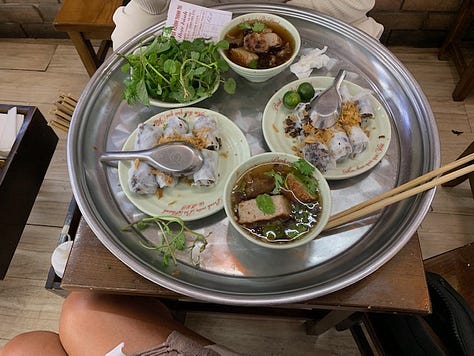
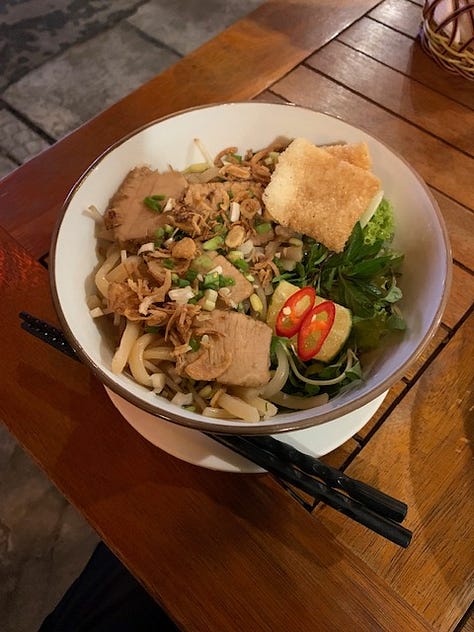
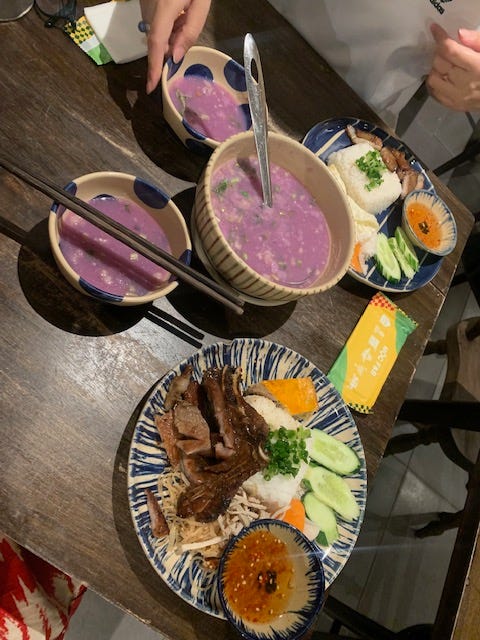
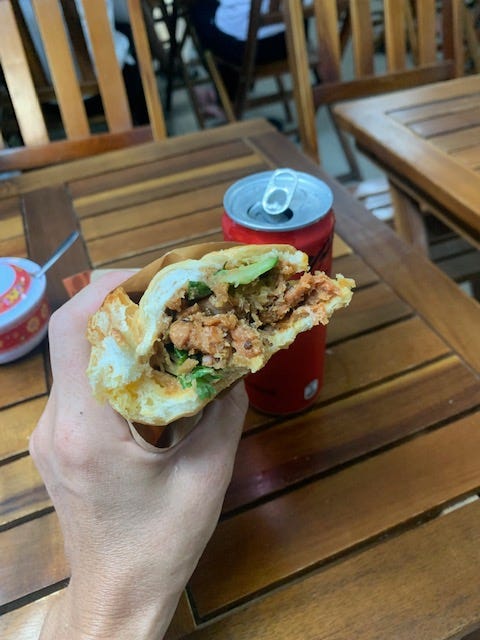
Hey! Would you like to connect over creativity, self-growth, and problem-solving? Or just to have a virtual glass of wine or mocktail? Please book a time on my Calendly for us to chat! I can’t wait to see you. XOXO.
If you’re enjoying On the Road, please share with others who you may think would enjoy as well! As always, I love reading your comments and feedback. If you're not already subscribed, please click the button below so I can continue sending you weekly-ish stories and lessons while I travel. 🚙

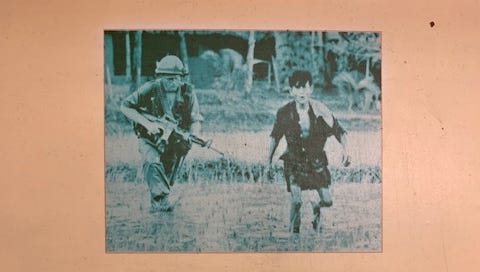



Thank you for sharing this history forgotten or never learned - to our detriment and to the detriment of the world. Thank you for your bravery to seek out, and face, and share.
And thank you also for sharing the beauty, hospitality, resiliency and cuisine of the Vietnamese people you have encountered.
Thank You for sharing your experiences in Vietnam.. the good, bad and ugly. I can only imagine the pain you experienced visiting the museum. You are also so much more braver than I am to try those new foods. The Bun bo Hue .. I would never. I'm living vicariously through you my friend : )